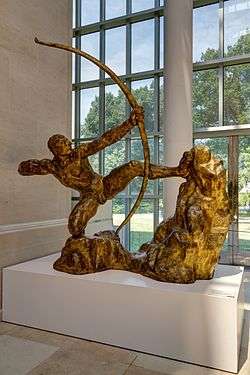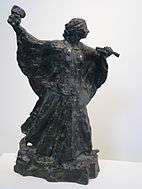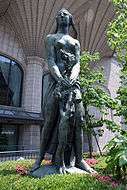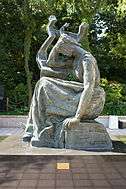Antoine Bourdelle


_(3713880263).jpg)

Antoine Bourdelle (31 October 1861 – 1 October 1929), born Émile Antoine Bordelles,[1] was an influential and prolific French sculptor, painter, and teacher.
His studio became the Musée Bourdelle, an art museum dedicated to his work, located at 18, rue Antoine Bourdelle, in the 15th arrondissement of Paris, France.
Biography
Bourdelle was born at Montauban, Tarn-et-Garonne. He left school at the age of 13 to work as a wood carver in his father's cabinet making shop. He learned drawing with the founder of the Ingres Museum in Montauban, then sculpture at the art school in Toulouse. At the age of 24 he won a scholarship to the École des Beaux-Arts in Paris, worked briefly in the atelier of Alexandre Falguière, and frequented the studio of Jules Dalou, who was his neighbor.[2]
In 1888 he did his first sculptures of Beethoven, producing authoritative work with an emphasis on order, the spirit of geometry, construction and invention. He became one of the pioneers of 20th century monumental sculpture. Auguste Rodin became a great admirer of his work, and by September 1893 Antoine Bourdelle joined Rodin as his assistant where he soon became a popular teacher, both there and at his own studio where many future prominent artists attended his classes, so that his influence on sculpture was considerable.
During his last years, Bourdelle received several commissions for monuments and war memorials. He was a participant in the 1913 Armory Show in New York, a founder and vice-president of the Parisian Salon des Tuileries. In 1909 he was named Knight of the Legion of Honor, in 1919 Officier of the Legion of Honor, and in 1924 became a Commander of the Legion of Honor.[3] Bourdelle's son, Pierre Bourdelle (1903–1966), became an artist most active in the United States, notable for his work at Cincinnati Union Terminal in 1933.
Bourdelle died at Le Vésinet, near Paris, on 1 October 1929 and was interred in the Cimetière du Montparnasse, Paris, France.
Work

_b.jpg)

Bourdelle's major work includes:
- spandrel reliefs for the portal of the Musée Grévin, Paris, 1900
- the Monument aux Morts de Montauban, 1902
- the freestanding gilded bronze Hercules the Archer, 1909
- the decorative series of friezes executed for the exterior of Auguste Perret's Théâtre des Champs-Élysées (1913). Although the building itself is famously an early example of concrete construction, the friezes are marble.
- interior frieze at the Opéra de Marseille, framing the stage
- the Monument to Mickiewicz near the Pont de l'Alma in Paris, designed in 1909, realized in 1929
- two angels on the crypt at the war memorial, Hartmannswillerkopf, for French architect Robert Danis, 1920s
- bronze tympanum Pieta for the Église Notre-Dame du Raincy, designed in the 1920s, finally realized and dedicated in September 1999
- equestrian statue of General Carlos María de Alvear, Recoleta, Buenos Aires
- war memorial, Capoulet-et-Junac
- bust of Jiddu Krishnamurti, 1928, located at the Krishnamurti Foundation Library, Ojai, California
Today the Musée Bourdelle in Paris sits amidst brick houses at 18 rue Antoine Bourdelle, a small street between the Gare Montparnasse and the offices of the famous French newspaper Le Monde. The museum consists of Bourdelle's house, studio and garden where he worked from 1884 to 1929. A second Bourdelle garden-museum, in Égreville, was established by his heirs in the late 1960s hosts another 56 of his sculptures.
His work is also exhibited in public collections worldwide, including the Aichi Prefectural Museum of Art (Japan), the Cleveland Museum of Art, National Museum of Art of Romania, the Courtauld Institute of Art (London), the Fine Arts Museums of San Francisco, Galleria Nazionale d'Arte Moderna (Rome), Harvard University Art Museums, the Hermitage Museum, the Hirshhorn Museum and Sculpture Garden (Washington D.C.), the Honolulu Museum of Art, the Kimbell Art Museum (Fort Worth, Texas), Kröller-Müller Museum (Otterlo, Netherlands), the Minneapolis Institute of Arts, Museo Nacional de Bellas Artes (Buenos Aires), the National Galleries of Scotland, the National Gallery of Australia, the Ingres museum in Montauban, the Royal Museums of Fine Arts of Belgium, and the Middelheim Museum (Antwerp, Belgium)
The teacher
Artists who studied with Antoine Bourdelle included:
- Athanase Apartis, Greece
- Alfredo Bigatti, Argentina
- Margaret Mary Butler, New Zealand
- Samuel Cashwan, United States
- Pablo Curatella Manes, Argentina
- Béni Ferenczy, Hungary
- Alberto Giacometti, Switzerland
- Angela Gregory, United States
- Otto Gutfreund, Czechoslovakia
- Bror Hjorth, Sweden
- René Iché, France
- Mladen Josić, Serbia
- Raoul Josset, France/United States
- David Karfunkle, Austria/United States
- Emile Lahner, Hungary
- Aristide Maillol, France
- Henri Matisse, France
- Vadym Meller, Russian Empire
- Vera Mukhina, Russian Empire/USSR
- Bencho Obreshkov, Bulgaria
- Dudley Pratt, United States
- Virginia Claflin Pratt, United States
- Germaine Richier, France
- Arnold Ronnebeck, Germany/United States
- Ada Mae Sharpless, United States
- Maria Helena Vieira da Silva, Portugal
- Risto Stijovic, Serbia
- Mihailo Tomic, Serbia
- Sreten Stojanovic, Serbia
- Josefina de Vasconcellos, England
- Helen Wilson, United States
- Teodors Zalkalns, Latvia
- Jose Luis Zorrilla de San Martin, Uruguay
- Ryumon Yasuda, Japan
For a first hand account of Bourdelle's teaching style see Arnold Ronnebeck's article from 1925, published in The Arts 8, no. 4 titled "Bourdelle Speaks to His Pupils: From a Paris Diary."
Gallery
%2C_bas-relief%2C_Th%C3%A9%C3%A2tre_des_Champs_Elys%C3%A9es_DSC09313.jpg)
Sculpture
-

The Great Warrior of Montauban, bronze, 1898, Hirshhorn Museum, Washington, D.C.
-

Dominique Ingres, Musée Bourdelle, Paris
-
Day and Night, marble, 1903, Musée Bourdelle, Paris
-

La Grande Penelope, bronze, 1912, Honolulu Museum of Art, Honolulu, Hawaii
-

The Sculptress at Work, 1906, bronze, Stanford Museum, Stanford University, California
-

Monument to Alvear Horse, Trammell Crow Sculpture Garden, Dallas, Texas
-

Dying Centaur, 1914, bronze, Musée Ingres, Montauban
-

La Liberté, Daido Life Insurance Company, Osaka, Japan
-

The Virgin of Alsace, 1919–21, Edinburgh, Scotland
-
Bust of Jean Moreas, bronze, National Sculpture Garden, Athens, Greece
-

Sappho, after the 1887 original, Kagoshima City Museum of Art in Kagoshima, Kagoshima prefecture, Japan.
References
- ↑ Birth certificate of Émile Antoine Bordelles, Ministère de la Culture et de la Communication, Leonore
- ↑ Ruth Butler, Rodin: The Shape of Genius, Yale University Press, 1993, page 266, ISBN 0300064985
- ↑ Ministère de la Culture et de la Communication, Leonore, Culture.gouv.fr
- Colin Lemoine, Antoine Bourdelle. L'oeuvre à demeure, Paris, Paris-Musées, 2009
- Bourdelle, Émile-Antoine, “Émile-Antoine Bourdelle, Sculptures and Drawings”, Perth, Western Australian Art Gallery, 1978.
- Ottawa.National Gallery of Canada, “Antoine Bourdelle, 1861-1929”, New York, C. E. Slatkin Galleries, 1961.
- Colin Lemoine, “Bourdelle”, Paris, Cercle d'art, 2004
- “Antoine Bourdelle, passeur de la modernité", exhibition catalogue (curators Roxana Theodorescu, Juliette Laffon and Colin Lemoine / Catalogue Colin Lemoine), Bucarest, National Museum of Art, 2006
- Colin Lemoine, “Le Fruit : une œuvre majuscule d’Antoine Bourdelle”, Ligeia, January–June 2005, n°57-58-59-60, p. 60-78
- Colin Lemoine, “...sans ce modelé à la Rodin, à la XVIIIe siècle qui beurre le tout : Bourdelle et la question d'un primitivisme occidental”, Bulletin du musée Ingres, May 2006, n° 78, p. 49-66
- Cléopâtre Sevastos, “Ma vie avec Bourdelle”, Paris-Musées-Editions des Cendres, 2005 (annoted edition by Colin Lemoine)
- Véronique Gautherin, “L'Oeil et la main” (2000)
- “Antoine Bourdelle, d'un siècle l'autre. L'eurythmie de la modernité”, exhibition catalogue by Colin Lemoine, Japan (Kitakyushu, Niigata, Takamatsu, Iwaki, Nagoya, Seoul), 2007-2008.
External links
| Wikimedia Commons has media related to Antoine Bourdelle. |
- Musée Bourdelle (in French)
- Portrait of Rodin from Antoine Bourdelle, on the official website of the Musée Rodin.
- National Art Gallery and Alexander Soutzos Museum, Bourdelle Emile-Antoine, Biography (in English)
- Antoine Bourdelle in American public collections on the French Sculpture Census website
| ||||||||||||||||||||||||||||||
|